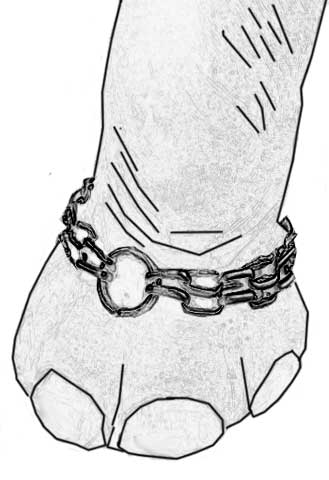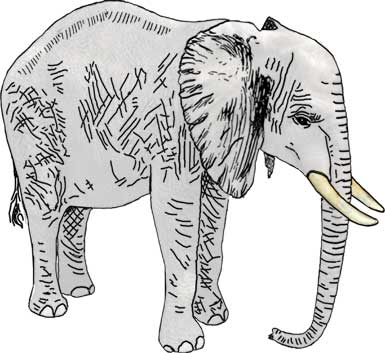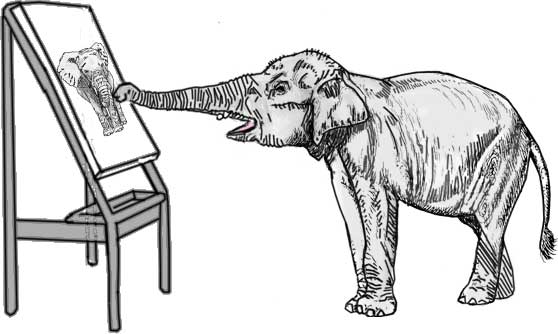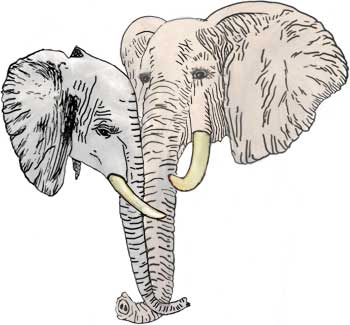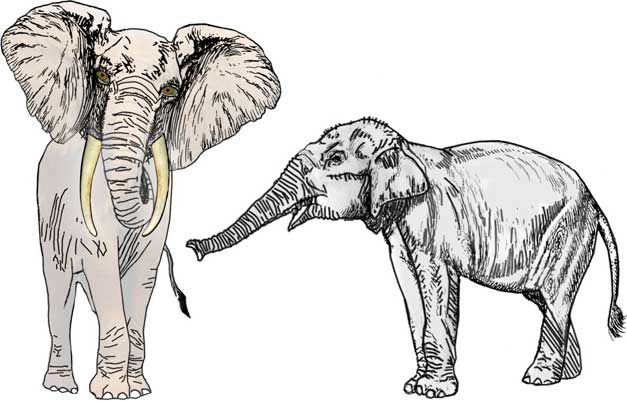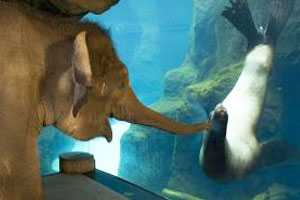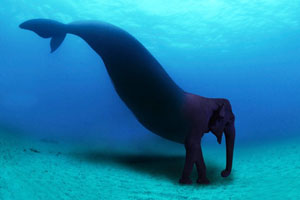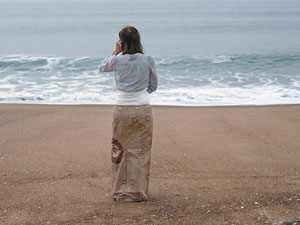Of all African animals, the elephant is the most difficult for man to live with,
yet its passing — if this must come — seems the most tragic of all.
I can watch elephants (and elephants alone) for hours at a time,
for sooner or later the elephant will do something very strange such as mow grass with its toenails
or draw the tusks from the rotted carcass of another elephant and carry them off into the bush.
There is mystery behind that masked gray visage, and ancient life force, delicate and mighty,
awesome and enchanted,
commanding the silence ordinarily reserved for mountain peaks, great fires, and the sea.
Seeing the Elephant
April 15, 2013
There is an old tale of the farmer who upon hearing that a circus had come to town excitedly set out in his wagon. Along the way he met up with the circus parade, led by an elephant, which so terrified his horses that they bolted and pitched the wagon over on its side, scattering vegetables and eggs across the roadway.
“I don’t give a hang,” exulted the jubilant farmer as he picked himself up. “I have seen the elephant.”
— Anthony Kirk
The question is, are we happy to suppose that our grandchildren may never be able to see an elephant except in a picture book?
— David Attenborough
Elephants are in danger of becoming extinct by the end of the century. Should this concern us? What benefit do they provide us? More than the cost of their preservation? Yes, because elephants have a rich inner life. They do matter.
Everyone knows that whales and dolphins and primates and African grey parrots are smart — maybe even really smart. Elephants, too, are smart. But they go further than that. Elephant groups have a culture and standards and they aren’t afraid to show their feelings. They have a mental health that can be detected from observations and interactions. They grieve; they get angry; they forgive; they get revenge. They’re smart in ways that seem surprisingly human — and sometimes make the same kinds of mistakes as humans do.
So, What Seems to Be the Problem?
Elephants are (perhaps unfortunately) quite large — in the wild, they need to browse over two full 8-hour shifts. Being huge protects them from big cats, hyenas, and other carnivorous beasts, but means they must constantly be searching for food to satisfy their giant appetites. That, and their imperative daily need for ample water means they may walk very long distances over a week. Therefore, in the wild, they have no fixed homes. Instead, they’re normally on the move (though they do have a more-or-less fixed range). For the females, who travel as a group with their children, it’s especially important to remember every food source, every watering hole in their sometimes gigantic range — from 15-3,700 square kilometres (24-5,958 square miles), depending on the density of the flora and the dependability of locating water. Site information may be passed from mothers to their daughters, who’ll normally spend the remainder of their lives in the same travelling group. Thus, elephants developed capacious memories for details — their “tools” are stored in the containers they carry with them everywhere anyway — in their heads and in their trunks. Elephants recognise other elephants (and people as well) even if they haven’t seen them for many years. They remember every unkindness, every snub, every fright, every blow, as well as every natural spring, field of young shoots, or sheltered overhang.
What’s an Elephant’s Day Like?
When the children get too tired, the matriarchal group stops to rest. Some of the elephants then sleep (stretched on the ground, stomachs rumbling while they constantly pass gas), others babysit, or keep watch over the sleepers. Their daily lives are always challenging, always new. They’ve survived like this for a long time — thousands of years.
But that time may be coming to an end.
Living in zoos means less constant foraging is needed every day. Elephants have more free time. Their thoughts broaden. Either they become depressed and cramped in the older zoos, housed in what unenlightened people of the day thought was quite sufficient accommodation, or else they’re bored in the bigger ones — few zoos can be made big enough for them to behave naturally. But some zoos, parks and sanctuaries have more space, more funding, and more understanding than others. The elephants in those places fare above average.
Is Being in Captivity Okay?
Elephants in captivity in the service of private enterprise overall likely have things worse. Perhaps small changes can be made that would, in the elephants’ opinions, make their circus or movie walk-on lives much more tolerable. But we can’t just ask them. So we guess — and often guess wrong. Perhaps the elephants in the entertainment industry are less bored than those in urban zoos. One video online shows a musical Asian elephant quartet playing harmonica and tambourine and even doing a synchronised dance — which they appear to be performing joyously. Another video shows a young female elephant at the Smithsonian’s National Zoo in Washington, DC composing short harmonica songs (after which caretakers and any audience within hearing respond with clapping). Many elephants have enough art skills to be taught to produce recognisable objects on canvas. Some of them seem eagerly engaged in these assigned tasks. But they are still nothing more than slaves in captivity. Always.
Is Being in the Wild Better?
In the wild today, the lives of elephants overall are often little better than those of their cousins in captivity. The elephants are mercilessly stalked and slaughtered for their tusks. Or they’re forced into overgrazing and near-starvation during drought years by their ever-diminishing habitat. Or they’re watching their adolescent children dying of thirst. Or they’re rampaging, angry and helpless, because of the hotel that’s been built across their established annual migration path. Or the matriarch is taking the time to go visit the bones of her ancestors, lovingly touching them before departing. Elephants display intense grief when one of their group dies. When they meet a friend on the path whom they’ve not seen in a while, they greet the friend with joy and trunk-hugs.
The males are looser — yet older males do instruct younger ones as to what behaviour is acceptable. After that, they all go out cruising, either alone or in pairs — young adults may even occasionally form gangs. Gang members sometimes get out of control and are reined in and split up by an elder.
It’s the Ivory, Isn’t It?
The elephants’ ivory tusks pose a terrible dilemma: they are constituted of a wonderful and versatile material, but the fact that each one is so valuable means poaching is inevitable — consider that a pair of tusks sold on the black market can sustain an unskilled Kenyan worker financially for 10 years. The men who poach often see it as the only way they can provide for their families.
Over the past 10 years alone, a staggering 62% of all forest elephants have been killed across their range in central Africa for their ivory. This severe decline indicates that extinction may be imminent. Almost a third of the land where African forest elephants were able to live 10 years ago is now too dangerous for them.
How Many Elephants Are Left?
The elephants in Africa are divided into two subspecies — forest and savanna. Most of the forest elephants live in central and western African rainforests. There are only about 80,000 forest elephants remaining. The forest elephants can be distinguished from the savanna elephants by smaller body size, smaller ears, and straighter, downward-projecting tusks. Savanna elephants are found throughout grassy plains, woodlands, swamps and bush lands, from sea level to high mountains.
The total number of elephants in Africa is probably around 500,000. That may sound like a lot – but in the 1930s and 1940s, there were 3-5 million.
For Asian elephants, problems are similar, only worse, if anything, due to greater natural habitat destruction. As few as 25,000 Asian elephants remain in the wild, scattered among 13 countries.
Another big problem with Asian elephants? Unemployment. Loss of traditional jobs, particularly in logging, has resulted in welfare problems not just for the elephants, but also for their handlers.
An odd thing about Asian elephants: some of the males have tusks, long incisor teeth that grow up to 5 feet long. However, most females and many males have only tushes — much smaller teeth that lack a central nerve and pulp (unlike tusks). They may be evolving away from tusks because those with the most robust tusk genes are killed before they have many offspring.
What Can Be Done for Them?
If a computer input device is developed that elephants of all ages can easily use and if large screens and sound pickups and speakers tuned to the correct frequencies can be installed in all zoos with elephants (there’s no money for this, but what if) then could the matriarchs perhaps stay in touch with one another? It could become like humans sitting down to watch a television programme, often comparing their lives and choices to the people being dramatised: elephants could compare their lives with each other online and jointly develop a new elephant culture more suited to today’s reality. All they need are tools they can easily use, some instructions they can understand, and practice. The younger they are when the lessons begin, the better
Elephants communicate with each other in many ways and with all their senses. They rely less on their eyes than humans do (though visual signals are important and the position of ears and trunks telegraph their mood). Their sense of smell can tell them something about another elephant’s health or sexual condition. Touch also conveys information. However, the main way elephants communicate deliberately is by sound. They vocalise using high-pitched squeaks down to deep rumbles (pitched too low for humans to hear, though elephants up to 8 kilometres away can hear them). Foot-stomping and low-rumbling generate seismic ground waves that can travel nearly 20 miles on the earth’s surface. Elephants can detect these through their sensitive feet.
What If?
Can computers someday allow humans to communicate with elephants (and whales and dolphins) in much the same way that they’re able to communicate with each other? (We’ve taught parrots to speak human languages and primates to use pictographs and sign language, but we lag in reciprocation.)
It might be helpful in the future if we could get elephants to understand the big picture. We could then ask them to select what they’d prefer among the pitifully few options humans are generally capable of making available to them. (Obviously, the choices are always funding-dependent.) We may find that some elephants prefer jobs of menial labour for 8 hours if it means they can spend the next 8 hours eating and talking with their families and friends. (Elephants can be tractor-substitutes for certain tasks and horse-or-camel substitutes for others.) Talking to elephants and other sentient creatures may not be so far-fetched in the future — except that elephants may not be around that long.
What about Right Now, Today?
How much importance do you place on elephants? Probably one isn’t a big part of your life (no pun intended). But consider this: there are certainly few species on Earth with the capability to ever communicate with humans in a meaningful way. Working with underwater creatures (such as whales and dolphins) is more difficult than working with land creatures. If we can’t figure out how to communicate better with the animals we’ve lived with for thousands of years, then we’d better hope aliens when they arrive come equipped with their own translation services.
Scientists once believed elephants were unable to use tools because they offered them long sticks to reach food placed outside the range of their trunks. Elephants ignored the sticks, leading researchers to conclude the animals just weren’t clever enough to understand the problem. But elephants use their trunks not only to reach food but also to sniff and touch it before deciding if it’s edible (they have an extraordinary sense of smell). For them, vision is secondary. As soon as they pick up a stick, their nasal passages are blocked. Now, feeling and smelling are both impossible. But give them food that’s out of reach above them, and they will push something they can stand on underneath the food, allowing them to reach it with ease.
The Oregon Zoo in Portland, Oregon USA has an Asian elephant named Chendra. She’s an endangered subspecies of elephant found on the island of Borneo, a pygmy elephant of which only about 2,000 exist in the wild. The subspecies is highly threatened by habitat loss and fragmentation. Chendra, now 10 years old, was discovered abandoned and hungry as a child. She had wounds on her legs and had lost the sight in her left eye. She’s currently the only Borneo elephant in North America. She’s lucky, though, in that she has larger Burma elephants as companions, though she’s unlikely to ever be able to have children of her own. (She’ll be too small to bear an offspring whose father is normal-sized.) In many places in the world, zoos are finding themselves with a single surviving elephant. These isolated elephants suffer terribly from loneliness.
Who Can Help?
There are many groups that have formed to assist in some way with the plight of elephants. An international conference on conflict between elephants and humans will be attended by anthropologists, ecologists, geographers, political scientists, historians, Sanskritists and zoologists (but no elephants) from around the world, held in Christchurch, New Zealand this May; it will focus on elephant / people conflicts in Southeast Asia. Asia’s elephant population has experienced a 90% decline over the past 100 years, a situation that has become critical due to a 95% natural habitat loss.
For more information, you can contact one of the following groups (or search for others online). We aren’t, at this time, affiliated with any of them, but they all seem sincere from their websites and endorsements (this isn’t to imply that any not listed DON’T have those characteristics — ours isn’t an exhaustive list):
- The African Elephant Specialist Group are technical experts who focus on the conservation and management of African elephants. The European Commission, the United States Fish and Wildlife Service, WWF International, and the UK Department for the Environment, Food and Rural Affairs are said to fund their core activities and specialised conservation action.
- Save the Elephants provides research, protection (via aerial surveillance of areas where poachers operate), education, and communicate to the public that elephants are intelligent creatures with complex levels of consciousness.
- The African Wildlife Fund says that while African elephants are native to 37 African countries, 8% of the total population is being poached annually. AWF works with communities who live in close quarters with local fauna to recruit, train, and equip wildlife scouts to monitor elephants. Scouts institute measures to prevent them from destroying crops, thereby avoiding having farmers view them as pests. Scouts also work to deter poachers.
What Is the Situation of Elephants in New Zealand?
New Zealand currently has two elephants: one African elephant and one Indian elephant.
The Single Indian Elephant
Burma is the only inhabitant of the Elephant Clearing in the Auckland Zoo. Her companion, Kashin, died in 2009. The Auckland Council has approved the Zoo’s proposal to bring two young Asian elephants to New Zealand to create a family for Burma, but there’ve been a number of delays. Female elephants are highly social creatures and Burma needs a group. She’s 29 years old and could live for another 40 years. Her welfare absolutely requires companionship. The focus for the zoo is to find two suitable young, compatible elephants abroad. Once the right pair are found, they’ll be quarantined in their country of origin, then sent by air to the island of Niue along with a small team of elephant specialists from the Auckland Zoo (they have a “team” of specialists they keep on hand for their single elephant?) to undergo further medical checks and quarantine before finally arriving in Auckland and meeting Burma.
Burma’s chance of successfully integrating into an already established herd at another zoo is less than her chance of establishing a role for herself as head of a pair of younger elephants at the Auckland Zoo where she now lives.
The Single African Elephant
Mila is located at the Franklin Zoo, also near Auckland. Unfortunately, Mila recently killed her zookeeper and friend. Mila had retired to the Franklin Zoo after performing in circuses for decades. Dr Helen Schofield, zoo owner, keeper, and veterinarian, developed a bond with 39-year-old Mila, who had arrived in late 2009 as a “jumpy, frightened” animal who had to be cared for through a protective wall. Under Dr Schofield’s care, the elephant became more pacified and settled in. But recently she had received an unexpected shock after brushing her trunk against the electric fence securing her enclosure. She was frightened. When the incident was reported, Dr Schofield went inside Mila’s enclosure with a bucket of fruit to try to calm her down. Mila was behaving strangely: she put her head down and advanced, slowly at first, but then with increasing speed. Dr Schofield backed away, but Mila (estimated to weigh about 3 tonnes) used her trunk to pull the doctor back. Mila then wrapped her trunk around the vet’s midsection, and picked her up. Dr Schofield calmly told Mila to put her down, so Mila knelt and released her. The doctor was still talking and was seen to move and Mila backed away, but then witnesses reported that she moved towards the vet again and repeatedly brushed her trunk against her. The doctor never moved again. (It was not made clear if the trunk-brushing contributed to Dr Schofield’s death.)
Staff members entered the enclosure and lured Mila away. When paramedics arrived, Dr Schofield was pronounced dead. A witness says the elephant was triggered to kneel down, crushing her keeper in the process, by what appeared to be a misinterpreted circus command: “down”. When Dr Schofield said, “Put me DOWN, Mila,” the elephant, going into circus mode, obeyed her command by dropping to her knees, thus crushing Dr Schofield. (Auckland Zoo’s female elephant, Burma, was taught her instructions in Hindi to avoid her obeying just such inadvertent commands.)
Neighbours said they could hear Mila trumpeting into the early hours of Thursday after the tragedy. She was inconsolable. Her former circus owner said that the suggestion the elephant had struggled to come to terms with living in the zoo after her life in the circus was wrong. He said he’d never had trouble with Mila and his children grew up around her. Dr Schofield had been full of enthusiasm for Mila’s future, hoping to eventually send her to live with other elephants in a bigger sanctuary, the renown Californian rehabilitation centre for former circus and zoo animals called Performance Animal Welfare Society, or PAWS.
Dr Schofield, who lived at the zoo with her sister and elderly mother, often slept with Mila in her enclosure when the elephant seemed troubled. She felt that she and Mila had become friends. Mila was not blamed and Dr Schofield’s death was considered a tragic accident.
In 1954 at the Auckland Zoo, 65-year-old Frank Lane died when the elephant Jamuna swung her trunk, knocking him into a wall. His death was also judged to have been the result of an accident, rather than an attack. Jamuna lived the rest of her life at the zoo without another incident.
The Franklin Zoo and Wildlife Sanctuary has now permanently closed. They are trying to find homes for all their animals. They’ve recently advertised for a keeper to care for Mila for up to a year until the $1.45 million needed can be raised via donations to transport her to her new planned retirement home in California.
Why Can’t Mila and Burma Move in Together?
This isn’t altogether clear. Mila is an African elephant and a different species from Burma, an Indian elephant. African elephants are carriers of endotheliotropic herpes virus. This herpes virus can remain latent in African elephants (some carry the virus but have no obvious illness while others become quite ill or die), but it can cause severe illness — and an 80% mortality rate — in Asian elephants.
There are also no medications that can ensure carrier animals are cleared of the disease. This implies that Mila is a carrier, though no tests were noted. Mila would therefore not be a suitable companion animal for Burma or any other Asian elephant that comes to the Auckland Zoo in the future.
PAWS appears to keep Indian and African elephants together with little problem. Their elephants seem well cared for (considering the fact that they’re captives) — so well cared for that the Detroit Zoo, America’s first major animal facility to give away its elephants solely on ethical grounds, sent their two Asian elephants to PAWS to live.
UPDATE: African elephant Mila is no longer in New Zealand. She is now a resident of the San Diego Zoo, thanks to the generosity of her many New Zealand supporters, some of whom remember her from her days in the circus (where she was known as Jumbo). About NZ$1.5 million was donated for her relocation. It isn’t clear why Mila didn’t go to PAWS as everyone had hoped, but at least she is with other elephants. She is now 41 and had not seen another elephant in 37 years. Six other African and Asian elephants, ranging in age from 33 to 49, live in the zoo’s 2.5 acre Elephant Odyssey complex. Asian elephant Mary, the oldest and the matriarch of the herd, was the first to meet Mila. A video was made of that meeting.
UPDATE 2 Anjalee, an 8-year-old Asian elephant, will be joining the Auckland Zoo’s 32-year-old female elephant Burma in about 3 months if all goes well. Anjalee arrived at Auckland International Airport on 14 March 2015 from Colombo, Sri Lanka, before taking off in a New Zealand Defence Force Hercules C-130 to Niue, where she will be quarantined for 90 days to ensure she is disease-free. A second elephant will be identified for transfer within a couple of years. This is excellent news.
We Like Elephants and Whales a Lot, but They’re Awfully Big
Federal Reserve Chairman Alan Greenspan on Thursday said growing US demand for natural gas to fuel factories and electricity plants
may outweigh environmentalists’ desire to preserve wilderness areas that contain energy reserves.
― Reuters 10 July 2003
- Chendra, an Asian elephant, comes face to face with Gus, a stellar sea lion, during one of her morning walks at the Oregon Zoo.
- I tried to find a photo of an elephant seeing a whale for the first time. I found one of elephant seals hiding on the beach until killer whales left the area, and… this. By the way, the closest land relative to whales are hippopotami.
- What do you suppose the whale is thinking to himself? This was taken in the San Ignacio Lagoon in Baja California. Apparently, the whale was purring.
Do we humans really need nature? The answers are “yes,” “no,” “maybe,” and “what, exactly, do you mean?” First, what IS the nature of Earth? In its most basic sense, you might call it a life support system. It runs the carbon cycle, cleans air and water, maintains stockpiles of obscure species in case they’re someday needed, provides a climate regulation facility, and otherwise supplies hundreds of vital services. It’s generally pleasant, often pretty. Put that way, of course we need it ― much as we need food, shelter, transportation and art.
Anyone who’s ever entered the Grand Canyon or walked among a grove of ancient redwoods knows there is a communion with geological time that occurs which dwarfs every step. But is it their age ― or their vertical nature that awes us? Is it nature that provides us with that delicious feeling of wonder? Maybe not. Some get that same reaction the first time they walk down the skyscraper canyon that constitutes Wall Street. Or see the Eiffel Tower.
But “Isn’t nature wonderful?” isn’t the question being posed. Nor are we being asked if we need a certain package of services, but if we need a particular method of their provisioning. There are many ways of providing equivalent services. While humans can’t generate them cost-effectively yet, our efforts to travel in space are already forcing us to address these issues. If humans are to travel to or live on the Moon or Mars (as many expect they will), then the answer is clear ― Earth’s nature is not absolutely indispensable.
Although Earth is large, it is not infinite. Further, much of it isn’t directly useful. Out of a total surface area of 52 billion hectares, only 11.4 billion is considered biologically productive (the rest is mainly desert, ice field, and open ocean). In 1900, every human could theoretically be allocated 5 or 6 productive hectares. In 2000, they’d get only 1.9 hectares. If, indeed, global population increase stops at around 11 billion, this will mean a future allocation of just one hectare per person/ Is this sustainable? How can we know? We couldn’t have supported today’s population with the technology available in 1900. We almost certainly can’t support the population in 2100 with our current technology. But can we support it with the technology we’ll have then? This is profoundly unclear. Should we restrain our future because we’ve suddenly lost our faith in the technology that has brought us this far? Especially when restraint might ensure failure?
We are being asked if we need nature, but how can we decide that if we lack a clear understanding of just what that means? Our ideas about nature are culturally determined and can’t really be considered objective as they are not immune from the influences of gender, nationality, or class. We find what we’ve learned to look for when we “see” nature. Further, the animals one feels must be saved from extinction also belong to a culturally-derived set. The Japanese tend to emphasise control over nature. In Germany, humans play a leading role, with nature found in park-like settings. In the US, the concept of wilderness is paramount.
We all value animals differently depending on whether we see them as food, pets, vermin, wall decorations or best viewed caged from a discreet distance. The meaning of “animal” is contested. This may seem trivial but is, in fact, vitally important ― by defining words, we define our world. The power of definition becomes especially evident when we run across descriptions that don’t correspond with our own understanding. For example, often cited because it’s so fascinating, Michel Foucault quotes from a Chinese encyclopedia:
Animals are divided into:
- belonging to the Emperor
- embalmed
- tame
- sucking pigs
- sirens
- fabulous
- stray dogs
- included in the present classification
- frenzied
- innumerable
- drawn with a very fine camel hair brush
- et cetera
- having just broken the water pitcher
- that from a long way off look like flies.
Recounting his reaction to that passage, Foucault cut to the heart of the concept that our reality is socially constructed ― in the wonderment of taxonomy, the thing that demonstrates the exotic charm of another system of thought is the limitation of our own system, the stark impossibility that we could ever think that. We all think we know nature. But what I know is not what you know.
If you ask them, most people will say that they want to live in a world that has “wild salmon and tiger salamanders and healthy forests and vibrant human communities where mothers don’t have dioxin in their breast milk.” Well, I want a million dollars. And a pony. And world peace, a bowl of cookies-and-cream flavoured ice cream, and a case of Pepsi Max. What we must know is if the things we want are worth the cost. A person may list “healthy forests” and “salmon” as important to his world, but somehow I doubt that he’s actually spending every penny not needed to keep himself and his family from starving or freezing on purchasing parcels of old growth or stretches of river rights in Oregon. But why not, if that’s what’s he feels is most important? The technical term for this is “revealed preference” and means how people act, as opposed to how they say they act.
Is the world better off with wild salmon? Perhaps so ― but at what cost? A big threat to salmon is river damming, otherwise known as hydro power. Hydro power is great ― cheap, reliable, and clean. Every kilowatt generated replaces a kilowatt generated some other way, which in the US would likely be from fossil fuels. Does anyone really advocate building more coal-fired power plants?
We need to assess what ecological benefit a threatened species provides: Does it offer a chance for direct economic benefit? What is its cost of preservation? How much of its disappearance rate is natural? Humans increase extinction rates 10-fold, some say more, but species also disappear on their own because their ecological niche changes. Would anyone seriously desire to cut extinction rates to zero? To freeze evolution? I doubt it. No one cried when smallpox became extinct, and in any case, efforts to stop evolution would be futile ― and tantamount to stopping the world.
More than a few animals have found the alterations humans have made to the environment positive ― not just rats, cockroaches, and pigeons but also pets and food animals. Britain recently changed their pollution regulations to outlaw dumping sewage into the sea, much to the dismay of the fish in the area. Some environmentalists tried to stop the change, but most sniffily complained that the fish and/or their environment had become “unnatural”. To the contrary! Taking advantage of opportunity is as natural as breathing. Fish living on other species’ waste is much like us needing oxygen, the toxic waste of blue-green algae.
As to the future: the potential resource hidden in the genetics of living things is huge and virtually untapped. Genetic engineering shows promise to extract value from the processes of the “natural” world. In time, all species will die ― even we humans (along with our solar system). What really concerns us with this “needing nature” business is properly regulating the speed of our demise ― staying around in comfort for as long as possible. The only real hope humans have of avoiding future cataclysm (asteroid strike or sun death) is to establish a base on another outpost in our solar system ― then in a different solar system. Yes, these are very long-term goals. But these objectives will never be achieved by putting curbs on human progress. We must hope that our ideas ignite into reality before we expend all our resources trying. Either we can live in relative comfort until the end of human time ― a seeming stasis which would mask the slow decay — or we can roll the dice and try for a jackpot. The two aims are incompatible; maximising our time on earth guarantees we’ll never get off it. Some environmentalists have a strong distaste for space travel, saying it “wastes” our resources on dreams. They express the cost of a launch in terms of how many starving children could be fed. I sympathise ― but I disagree. It’s time we humans learned to fly.
It is important to understand the benefits and drawbacks, both direct and indirect, of maintaining a rich biodiversity. Benefits and costs must be properly valued when making economic decisions. Our present dearth of knowledge in this important area means that our valuations are artificial. This must change. For now, we shall maintain the capability of the world to adapt to change and maintain our planet sufficient to continue our species ― until we can devise adequate alternatives for both nature and Earth.
Whale and elephant behaviour is not only complex, it’s also surprisingly similar. The females of either species live in highly social family units that rely on well-developed communication. The much larger males live separate, more solitary lives, roving between female groups during the breeding season, delaying breeding until they are large and dominant. Yet those matriarchal family groups, as well as the loosely organised bands of males, are marked by physical contact and care for one another. Groups of whales, or of elephants, spend many hours a day together, rubbing up against one another, caressing each other with flippers or with trunks, and quietly talking among themselves.
Conversation among sperm whales takes the form of patterned sets of clicks whose frequencies can vary from 200 to 32,000 Hertz. Elephants use very low frequency sound (below the threshold of human hearing) to speak with one another. Both species live to the age of 60-80. Both almost certainly remember long-past events. And individuals of both species act heroically to protect other members of their group.
Like humans, whales and elephants are adaptable. Their diets, like ours, are varied and flexible. During the Miocene epoch, various kinds of elephants lived everywhere on Earth except Australia and Antarctica. Sperm whales today range the oceans from Antarctica to Greenland. Now, of course, we gradually hem in whales and elephants as we mindlessly carry out their extermination. The consequences of that ongoing extermination are huge. Both whales and elephants play large roles in the ecology. We humans don’t yet kill quite as many fish as whales do, but we soon will. The problem is, our consumption is new to the ancient balance of nature. It threatens the very existence of whales themselves. And removing whales (or any of the large species) promises vast and unpredictable disruptions of the ecology. We’re eliminating what are the most intelligent species on Earth — intelligent in ways we don’t begin to understand. We might well get away with that killing and still survive. If we do, of course, it’ll be in a greatly altered world.
How many whales are killed each day? On average about 20, depending on the season. Eleven countries hunt whales. Most (not Japan or Norway) only allow hunting by native populations. Here are the average numbers of whales killed each year:
- Canada: 1 bowhead whale every two years from Hudson Bay, 1 bowhead whale every 13 years from Baffin Bay.
- Faroe Islands: 950 pilot whales (actually a species of dolphin) a year.
- Greenland: 175 whales a year.
- Iceland: 30 minke whales and 9 fin whales a year.
- Indonesia: Two small islands in Indonesia hunt whales with traditional harpoons thrown from small open boats; they kill between 10 and 20 whales a annually.
- Japan: The quota for 2009-2010 was 935 minke, 50 fin and 50 humpback whales, but the Japanese fishing fleet returned home with less than half their catch after opposition and disruption from anti-whaling ships. About 20,000 dolphins and small whales are killed each year by coastal fishers. In 2009 about 150 large whales were accidentally caught in fishing nets used for coastal fish.
- Norway: The quota for 2011 was 1286 minke whales.
- Russia: The native people in the Chukotka region kill 140 grey whales a year.
- St Vincent the The Grenadines: 4 humpback whales a year using traditional boats and harpoons.
- United States: Indigenous communities in Alaska kill 50 bowhead whales a year.
That’s about 7,400 whales a year, (not counting the coastal dolphins of Japan) or about 20 a day.
“Shooting an Elephant” is an essay by George Orwell. In it, he describes a what happens one morning in a small town in Burma during the mid-1920s. An elephant gets loose, tramples a bazaar, and kills a man. Orwell, as the town’s imperial police chief (a white man not respected at all by the locals), has the responsibility to keep people safe. He also has a gun. When Orwell finally tracks down the elephant, he finds it calmly eating bushes. Orwell realises that the elephant’s musth (sexual frenzy due to a nearby female in estrus) is already over. Killing it is pointless except that the crowd of hundreds watching him want to see it die. Orwell realises that, rather than being any kind of real leader, he’s a puppet, controlled by the will of the crowd. He writes, “I perceived in this moment that when the white man turns tyrant, it is his own freedom that he destroys. He becomes a sort of hollow, posing dummy, the conventionalised figure of a sahib. For it is the condition of his rule that he shall spend his life in trying to impress the natives and so in every crisis he’s got to do what the natives expect of him. He wears a mask and his face grows to fit it. I had to shoot the elephant.” So he does — because he doesn’t want the crowd to laugh at him or boo him. (Too bad about the elephant.)
- The English book: Elephants I Have Shot on Safari
- The Welsh book: The Elephant and Its Influence on Welsh Language and Culture or Oes ysgol tocynnau eleffant llanfairpwll nhadau coeden
- The American book: How to Make Bigger and Better Elephants
- The Japanese book: How to Make Smaller And Cheaper Elephants
- The Greek book: How to Sell Elephants for a Lot of Money
- The Finnish book: What Do Elephants Think of Finnish People?
- The German book: A Short Introduction to Elephants Volumes 1-6
- The Icelandic book: Defrosting an Elephant
- The Swiss book: Switzerland: The Country through which Hannibal Went with His Elephants
- The Canadian book: Elephants: A Federal or State Issue?
- The Swedish book: How to Reduce Your Taxes with Elephants
Keeping Our Illusions
- The problem with the play on the name van Gogh is that the reader needs to think that the artist’s name is be pronounced “van go” (as Americans do) — but that is a wrong pronunciation. See this clip from QI for the proper way to say it or listen here.
- This scene was deliberately set by a rather creative photographer.
- If you’re one of those people who don’t immediately see the illusion, try this photoshopped version.
In case you don’t know what those changes involve: longer ears, changed face shape, thinner lips, higher forehead, too much skin.
The Influence of Genes
This is another way to illustrate the passage of time — only this photographer skillfully blends different halves of two close relatives who have an usually close resemblance to each other. Some of the photos on his site blend male and female photos or twins. Some of the photos raise fascinating questions.
Why do chemists call He, Cm and Ba the medical elements? Because if you can’t helium or curium, you barium.
 Animals
Animals Animation
Animation Art of Playing Cards
Art of Playing Cards Drugs
Drugs Education
Education Environment
Environment Flying
Flying History
History Humour
Humour Immigration
Immigration Info/Tech
Info/Tech Intellectual/Entertaining
Intellectual/Entertaining Lifestyles
Lifestyles Men
Men Money/Politics/Law
Money/Politics/Law New Jersey
New Jersey Odds and Oddities
Odds and Oddities Older & Under
Older & Under Photography
Photography Prisons
Prisons Relationships
Relationships Science
Science Social/Cultural
Social/Cultural Terrorism
Terrorism Wellington
Wellington Working
Working Zero Return Investment
Zero Return Investment
